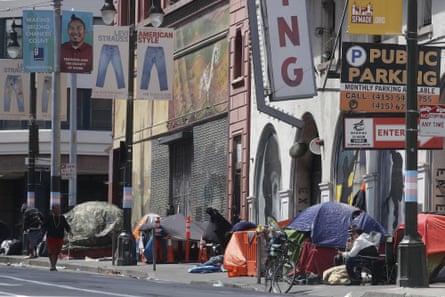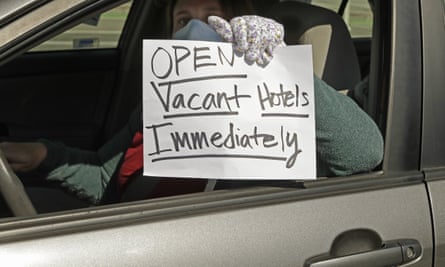On the streets of San Francisco’s Tenderloin neighborhood, social distancing does not exist.
Tents and blankets cram the narrow sidewalks, even set right against sun-faded buildings. Occupants of these encampments loll on the pavement nearby, hyper cognizant they risk losing their belongings if they leave.
Makeshift shelters and overflowing carts are in constant conflict with pedestrians for six feet of space. Passing through sometimes means pushing through crowds, weaving around camp debris, blankets and waste as flies bounce off face coverings.
In the Tenderloin, social distancing does not exist because many of the neighborhood’s unhoused residents have nowhere else to go. Weeks into the global coronavirus pandemic, as San Francisco prepares to cautiously reopen, the historically low-income and underserved neighborhood once again finds itself experiencing a very different reality than the rest of the city.
While other parts of the Bay Area look like “outtakes from The Good Place”, the Tenderloin “isn’t even third world at this point”, said Kathy Looper, owner of the Cadillac Hotel in the neighborhood. “I’ve been to third world countries that look better than this,” Looper said.

The Tenderloin has long been a refuge for some of San Francisco’s most vulnerable, displaying a vicious cycle of homelessness, addiction and mental illness in the heart of the city. But the pandemic – and the city’s homeless policies during the pandemic – helped create a perfect storm within the neighborhood’s 35 blocks. In order to be able to enforce social distancing guidelines, San Francisco’s overcrowded homeless shelters drastically reduced their capacity. The city made hotel rooms available to homeless people, but only those who had tested positive for the virus or ranked among the most vulnerable. Many unhoused people suddenly had no other choice but to take to the streets, some fortunate enough with tents and others making do with what they could find. Amid a lack of testing, it’s unclear how widespread the virus is in the neighborhood, among the housed and unhoused.
“I really don’t know what to do,” said Roger Moussa, 51, who has been sleeping on the streets since his shelter bed reservation ran out a month ago. “I feel completely helpless. I have nowhere to go, and every other night I get robbed.”
Tents have sprung up throughout San Francisco’s 49 sq miles since the start of the coronavirus outbreak, but in the Tenderloin, the number of tents had exploded by 285% – 268 tents total. Neighborhood residents believe this to be an undercount, with some tallying 432 tents as of last week.

“This is not a way for people to live, especially now, and the city is not providing any solution,” Looper said. “They herded everyone into this one neighborhood and said it’s OK, but it’s not OK. They created their own Warsaw ghetto.”
Several unhoused people said they weren’t trying to make life difficult for the housed Tenderloin residents. Many have community ties, with some living in the supportive housing offered there before becoming homeless again. Given the option, most of them wouldn’t be sleeping on the sidewalk; they didn’t have a choice.
“I tried to go into the men’s shelter but they said the corona had came out,” said Abdull Best, 25. “You can’t get into a new shelter while it’s quarantined. No new residents during the quarantine.”
The city has responded with a Tenderloin Neighborhood Plan that includes more public restrooms and hand-washing stations. It launched several “safe-sleeping sites,” city-sanctioned encampments with access to some amenities and services and identified 13 of the hardest hit blocks for cleaning and clearing. “I want to really recognize that this is going to be a targeted plan, a challenging one, and we are set to be as aggressive as we can in implementing it so that the people in the community can see a difference,” said Mayor London Breed.
For many in the neighborhood, it’s yet another empty gesture in a long history of empty gestures. Residents have grown accustomed to being overlooked by the powers that be. Located just three blocks from the towering beaux-arts majesty of city hall, the neighborhood has long been written off as an open-air drug market and homeless hub. Tourists are warned to avoid it. Fox News and conservative media relish in attacking it, splashing live shots of feces and syringes on the pavement as proof of the city’s failings.

But it’s also one of the most diverse and densely populated communities in the city: 31% of the neighborhood is Asian, 23% is Latino and 10% is black. In San Francisco, a city with the most billionaires per capita in the world, the median household income is $104,552. In the Tenderloin, where 30% of the neighborhood is in poverty, the median household income is $23,513.
A term frequently used with the Tenderloin is “containment zone”. For years, residents have viewed this as the city’s tactic in dealing with the neighborhood. “There’s inherent pressure in urban life, with homelessness and drug dealing and mental illness – just urban realities,” explained David Faigman, dean and chancellor of the UC Hastings Law School, which is located in the neighborhood. “And if we can keep it in the Tenderloin, we’re not going to see it in the Marina. We’re not going to see it in Pacific Heights.”
Earlier this month, UC Hastings filed a federal lawsuit against the city, joined by the merchants and property association and some other residents. The lawsuit seeks to compel the city to clear the sidewalks and clean the streets by providing healthy and safe options for the unhoused population in the encampments.
“We could have brought a lawsuit 10, 15, 20, 25 years ago and we probably could have had standing,” Faigman said. “We would have had neighbors who were fed up with what they were dealing with. But what they’re dealing with now is at such a much more profound level. We have a virus that could possibly be deadly, and we don’t know how prevalent the pandemic is out on the streets. You have people in wheelchairs, children and the elderly who need to maneuver around a population that may have a very high rate of Covid-19.
“There has always been an underlying health crisis,” he continued. “But now it’s a true exigent emergency.”
To many in the neighborhood, the city’s homelessness policies amid the pandemic have continued to institutionalize homelessness within the neighborhood borders, rather than try to solve the issue with housing. “The time they spent writing the plan they could have spent moving people into hotels or sanctioned encampments,” said Randy Shaw, executive director of the Tenderloin Housing Clinic.
And many recognize that nothing will change until those without shelter can safely get off the streets. “There is a literal plague sweeping the country and our city and we are only as safe and as protected as our most vulnerable residents,” said local lawmaker Matt Haney, who represents the Tenderloin.

The crisis unfolding in the Tenderloin has created light tension in the world of homeless outreach. Residents’ demands for clearing tents and sweeping encampments can come across as anti-homeless, but many of those advocating for the measures work in homeless outreach. It’s not that they’re against homeless people – it’s that “no one should be in those tents”, Shaw said. “Everyone should agree they should either be in hotels or in supervised encampments. They shouldn’t be on sidewalks in the Tenderloin.”
There needs to be concern for the housed residents of the Tenderloin as well, Shaw said, many of whom do not have the luxury to work from home and have to make their way through the crowded streets every day.
“There’s a level of despair in the Tenderloin that I’ve never seen before,” Shaw said. “What does it say to these families that the city government will allow these conditions to proliferate right on the sidewalks? It sends a message that they’re not valued at all.”
One week after the city announced its Tenderloin Neighborhood Plan, tents and makeshift structures still crammed the sidewalks, their occupants never too far away. The few public restrooms available had lines down the street.

The city has recommended establishing a testing site as part of its Tenderloin assessment report and has begun setting up the sanctioned encampments. Homeless outreach advocates worry that it won’t be enough. The camps must still adhere to social distancing, so they will only accept a limited number of people. Priority is going to the medically vulnerable and those who are already in the city system.
Haney, the local lawmaker who represents the Tenderloin, believes that what happens in this neighborhood will determine how long the city’s stay-at-home order will last. “Can San Francisco meet the metrics the governor has put forth if we have so many people who cannot shelter in place?” he said.
Because what Haney and homeless outreach advocates have been saying since the mayor declared a state of emergency is that viruses don’t stay within income brackets or sociological boundaries. The impact on the Tenderloin already demonstrates the direct effect that the unhoused population in a pandemic can have on a housed population.
“This isn’t even about doing the right thing for disenfranchised people, or charity,” Haney said. “When they get sick, you and your families will get sick as well.”
